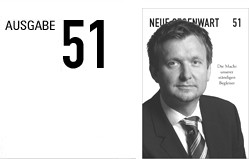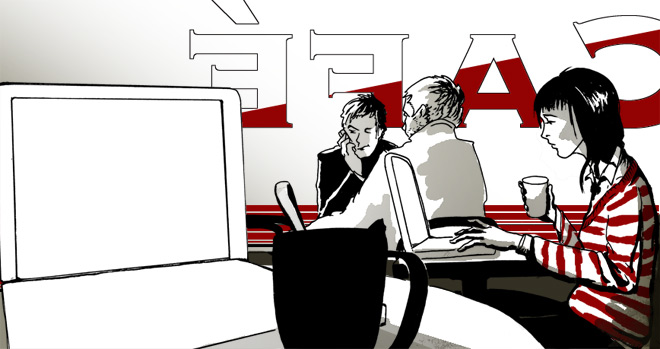|
Immer mehr
Medienkanäle fordern unsere Aufmerksamkeit. Ob SMS-Nachrichten geschrieben,
E-Mails gelesen und beantwortet, Nachrichten-Sites durchsucht,
Blog-Einträge verfasst und kommentiert oder Wikipedia-Artikel verändert werden
wollen
–
wer nichts verpassen kann, muss scheitern. Wer seine Prioritäten nicht
angemessen setzt, geht im Strudel unter. Wer seine Aufmerksamkeit so weit
teilt, dass alle Kanäle gleichzeitig bedient werden können, muss in einem
Zustand landen, den Linda Stone "constant crisis" nennt.
Stone weiß, wovon sie spricht. Mehr als
20 Jahre lang war sie im Top-Management von Computerkonzernen
tätig. 1986 begann sie ihre Karriere bei Apple, "to help change the world". Sieben Jahre
später wechselte sie dann – ausgerechnet
– in die Forschungsabteilung von
Microsoft. Sie wirkte an der Gründung der heutigen
 Social
Computing Group (damals Virtual Worlds Group) mit, die sich unter
der Leitung des Microsoft-Veteranen Social
Computing Group (damals Virtual Worlds Group) mit, die sich unter
der Leitung des Microsoft-Veteranen
 Nathan
Myhrvold
mit der Erforschung des Soziallebens in virtuellen Communities beschäftigte.
Von 2000 bis 2002 arbeitete Stone schließlich als Corporate Vice President
direkt für Microsoft-CEO Nathan
Myhrvold
mit der Erforschung des Soziallebens in virtuellen Communities beschäftigte.
Von 2000 bis 2002 arbeitete Stone schließlich als Corporate Vice President
direkt für Microsoft-CEO
 Steve
Ballmer. Heute schreibt sie Kolumnen für angesehene Zeitungen und
Zeitschriften und spricht auf Konferenzen über ihre Erfahrungen und
Erkenntnisse. Steve
Ballmer. Heute schreibt sie Kolumnen für angesehene Zeitungen und
Zeitschriften und spricht auf Konferenzen über ihre Erfahrungen und
Erkenntnisse.
Auf der internationalen Medienkonferenz
 Digital
Life Design, die Hubert Burda Media im Januar 2007 zum
wiederholten Male ausgerichtet hat, sprach Linda Stone über eine der aus ihrer
Sicht wichtigsten menschlichen Eigenschaften: die Fähigkeit, die eigene
Aufmerksamkeit steuern zu können. Neue Gegenwart
freut sich darüber, den Vortrag von Linda Stone in dieser Ausgabe im Originaltext
veröffentlichen zu können und dankt Linda Stone für die freundliche
Unterstützung. Digital
Life Design, die Hubert Burda Media im Januar 2007 zum
wiederholten Male ausgerichtet hat, sprach Linda Stone über eine der aus ihrer
Sicht wichtigsten menschlichen Eigenschaften: die Fähigkeit, die eigene
Aufmerksamkeit steuern zu können. Neue Gegenwart
freut sich darüber, den Vortrag von Linda Stone in dieser Ausgabe im Originaltext
veröffentlichen zu können und dankt Linda Stone für die freundliche
Unterstützung.
Linda Stone:
"I want to start with a quick quiz for you.
Raise your hand every time a
statement is true for you:
1. I keep all my communication devices on
all the time so I don’t miss
anything.
2. I turn my communication devices off
and I don’t care if I miss calls,
emails and so forth.
3. The way I currently use computer and communications technologies improves
my quality of life.
4. My quality of life is often compromised by technology.
5. Technology sets me free.
6. Technology enslaves me.
For most of us, ALL of these are true. Our world is noisy and we use every
tool we have to keep up and to stay on top of everything.
At the same time, there’s a desire in many of us that’s growing – a desire
to get to the bottom of things, to enjoy more signal and less noise and to
cultivate meaningful relationships rather than the < me and everyone else
network >.
We are on the cusp of one Age of Attention and moving into another. We have
been in the Age of Continuous Partial Attention for the last twenty years.
We are just now entering the Age of Uni-focus. Trends start slowly, then
accelerate. The first signs of the shift are starting to show up in this
messy transition time. By 2014, we will be in the prime of this Era.
Continuous partial attention is fueled by the urge not to miss anything.
Every call, every email, every text message, every blog post, every person
wandering by, just might have value, might call us toward the next great
opportunity or experience.
Continuous partial attention is different from multi-tasking. The Age of
Multi-Tasking preceded the Age of Continuous Partial Attention.
Multi-tasking is motivated by a desire to be more productive and more
efficient. The multi-tasker gives the same priority to a variety of
activities that don’t require much cognitive processing. We’re multi-tasking
when we eat lunch, talk on the phone, and file or copy papers at the same
time. We’re just being in the business of getting things done. We multi-task
to CREATE more opportunity for ourselves – opportunity to DO more, to PLAY
more, to CREATE more. We use continuous partial attention to SCAN for
opportunity, to connect more, to be a live node in a web of endless
possibilities. With every opportunity, we ask, “What can I gain here?”
When William James, defined attention in 1890, in Principles of
Psychology, he said that it is taking possession of the mind in clear
and vivid form, of one out of what seem several simultaneously possible
objects or trains of thought… it implies withdrawal from some things in
order to deal effectively with others.
Today, a commonly used definition of attention is: the act or faculty of
attending. We seem to have completely dropped the part about withdrawal from some things in order to deal effectively with others.
We’re just doing it all.
Continuous partial attention (cpa) is an always on, anywhere, anytime, any
place behavior. It’s neuro-chemically addictive and it involves an
artificial sense of constant crisis. We keep a top priority in focus. At the
same time, we scan the periphery to see if we are missing other
opportunities, and if we are, our very fickle attention shifts focus. What’s
ringing? Who is it? What email just came in? 15 text messages. Blog this.
What time is it in Beijing? 19 voicemails.
The artificial sense of constant crisis is more typical of continuous
partial attention than it is of multi-tasking. In this state of constant
crisis, our adrenalized Fight or Flight mechanism kicks in. This is great
when a bear is standing ready to rip us to shreds. How many of those 500
emails a day is a bear? How many are flies? Is everything an emergency? Our
way of using the current set of technologies would have us believe it is.
Over the last twenty years, we have not only become expert at paying
continuous partial attention, we have become skilled in paying – CONTINUOUS
continuous partial attention. There are times when CPA is the best attention
strategy for what we’re doing. There are times when we can’t seem to shut it
off and it’s not the best match. In small doses, continuous partial
attention has served us well.
Continuous continuous partial attention, an always-on lifestyle, and the
fight or flight response associated with it, sets off a cascade in our
bodies, starting with norepinephrin and it’s friend, cortisol, a stress
hormone. As a hormone, cortisol is a universal donor. That is, it attaches
with any receptor site leaving little room for other hormones. As a result,
dopamine and seratonin – hormones that help us feel calm and happy – have no
where to go. The abundance of cortisol has contributed to our turning to
pharmaceuticals to calm us down and help us sleep. Consider the success of
drugs like Ambien, a non-narcotic sedative-type sleep medication, and
anti-depressants, like Prozac. We have more attention-related and
stress-related diseases than ever before. We can’t find the off switch -- on
our devices or on ourselves. As we begin to consider the impact of this
lifestyle, researchers are beginning to tell us that we may actually be
doing tasks more slowly and more poorly.
We are beginning to shift away from a desire to be always-on, and moving
toward a desire to protect our time, and to experience more meaningful
relationships. We are moving from what I call the “I CONNECT” Era and the
Age of Continuous Partial Attention and into the “I PROTECT and BELONG Era.”
An era, that, over time, will be characterized by Uni-Focus and Presence.
The world may continue to be noisy. Our yearning and fulfillment going
forward will be more and more likely to come from getting to the bottom of
things, from stillness, authenticity, meaningful connection, and a sense of
protecting ourselves and being protected. Neo-Luddites Rising! OR… I know
how to use the tools and I choose not to right now.
A self-described internet-addicted, blog until she drops, level 60 Troll
Priest on World of Warcraft, friend of mine, sent me the following email
recently:
I’m sorry I've been so awful about reading and responding to email. I think
I'm having a CPA backlash reaction, and have spent most of my time lately
doing things like crocheting and photography! Check out my Flickr site to
see my crochet projects.
Three years ago, this person was so tethered to her computer that her email
response time was generally under 3 minutes. These last few months, it can
take weeks to get a response.
Recently, I was with a handful of New York moms. While they all use
Blackberries, they had harsh words for excess use of that technology. “Our
husbands come home from work, glued to their Blackberries. They don’t talk
with us or with our children. They don’t connect with us. And then when we
go to bed, they want sex. I don’t think so.” Birth control – an unintended
consequence from Research in Motion.
Overwhelm, over-stimulation and lack of fulfillment are the shadow side of
our desire to connect and our always-on Age of Attention. The latest,
greatest powerful technologies have contributed to our feeling increasingly
powerless.
These feelings are seeding new longings. The younger generation, in this
case, the Millenials, is always at the frontline of new attention behaviors
and of the next era. The behaviors emerge, then drift across all generations.
Millenials consider phone calls intrusive. Before you call, IM or text to
see if the call is welcome.
Those 42 million iPods sold to date…. Those iPod earbuds…. They say, “Leave
me alone. I want my space and I’m in it. I’m taking control of what input
comes my way.”
MySpace – it’s a way of feeling connected without having to dedicate a lot
of time. Drop in. Drop out. Some of the social network software that
preceded MySpace requires more time and more management.
Most daunting to managers of Millenials is the attitude that it’s okay to
leave work by 6 pm. That it’s okay to leave, turn the phone off, and have a
life. A work to live orientation could ultimately replace the live to work
lifestyle.
The always-on lifestyle, with endless opportunities for communication and
interaction -- or put another way – endless stimulation – is gradually being
replaced with evidence of an emerging desire for exhilaration – specifically,
the exhilaration that comes with creation and being creators. Stimulation is
all about those things that come at us externally. Exhilaration comes from
within.
In the unfolding, we’ll see the <me and everyone else network> replaced by
meaningful networks that are like “tribes.” In games like World of Warcraft,
players experience meaningful relationships on a new level for multi-player
games.
With developments like the Wii and the serious games movement, we’ll also
see games evolve from continuous partial attention FIRST PERSON SHOOTERS (FPS)
to games like SPORE, games that enhance uni-focus and a sense of presence in
the game play. Games that support a “possibility space.” Uni-focus and
presence are a soothing follow on to a CPA world.
Consider new technologies like the iPhone and the Wii. Both support direct
manipulation. On the iPhone, users “pinch” to re-size photos and “flick” to
scroll through a contacts list, using gestures that are very natural. On the
Wii, the remote supports natural movements for games like golf and tennis.
While continuous partial attention FPS games took us out of our bodies,
these new technologies, that support direct manipulation, take us back into
our bodies.
While Millenials are at the leading edge of these new attention behaviors,
they are not alone in feeling a calling toward protection and protectors.
Just as the Era of Connecting and the Age of Continuous Partial Attention
define who we are individually and collectively today, The Era of Protection
and Belonging and Age of Uni-focus describes who we are becoming.
Everything in nature that works seems to have a cycle – the life cycle of a
plant, the seasons – summer, fall, winter, spring. Athletes train with
cycles in mind – cycles of high performance, cycles of different types of
workouts, periods of rest. Always on doesn’t respect this. And if there is
no winter, there is also no spring.
As we move forward, we never totally give up what we integrate from eras
past. We simply shift focus and embrace new thoughts of what will bring us
that which we have come to long for.
We are moving from asking, “What do I have to gain?” to asking, “What do I
have to lose?” These feelings are inspiring us to want to reach for a higher
quality of life.
We want to sort through noise effectively to find a meaningful signal. We
want DVRs, Netflix, Youtube, and iTunesTV. We want an iPhone. In part, we
want it for the visual voicemail that lets us control which messages we
listen to, in the order of our choice, without having to listen to all
the messages.
We want Google – for now, a trusted technology that we believe protects us
from a web so vast we could drown in the over 12 billion pages. We are drawn
to the marketing messages and the companies that evoke feelings of trust and
safety and a feeling of being protected. Authenticity, trusted authorities,
and clear, uncluttered messages are part of this new era.
Since 1965, we have shifted from multi-tasking, and a desire to CREATE
opportunity, to continuous partial attention and a desire to SCAN for
opportunity, to, now, uni-focus and a desire to DISCERN opportunity.
To discern which opportunities we prefer and to focus on those, will
characterize our evolution beyond the always-on lifestyle.
Signs of the new times: Think Apple. Think iPod. At an ArtCenter Design
Conference, Jonathan Ive, Apple design guru, described how, with the iPod,
his team had a strong and deliberate sense of focus and purpose and a
relentless drive to take everything away that was extraneous.
While this kind of thinking has always been at the heart of great design,
we’re about to see mass consciousness sync up, creating an opportunity for
mass consumption of quality design. Target stores are tapping into this as
they work with designers like Michael Graves on product lines for their
customers.
Apple Inc. resonates with collective consciousness today in a way that is
building market share more rapidly than in the last decade. Apple is
well-positioned to do well in the Age of Uni-Focus and Presence.
Uncluttered says QUALITY OF LIFE and is an anti-dote to overwhelm and
over-stimulation. For every product, service, feature, and venue -- we’ll
ask, does it enhance and improve my quality of life?
With products and services, since 1965, we have evolved from a focus on
features, to a focus on ease of use, and now, I believe we’ll care most
about products and services that offer us quality of life.
Ease of use has been the mantra of every technology columnist, every product
manager in every high tech. company. It’s good. But it’s not good enough.
The new mantra, the new differentiator, the new opportunity for all of us
is: improves quality of life. Does this product, service, feature,
message -- enhance and improve our quality of life? Does it help us protect,
filter, create a meaningful connection? Does it support discernment? Does it
support us in using our attention as well and as wisely as we possibly can?
Attention is the most powerful tool of the human spirit. Attention, as
expressed by an individual, is at the very core of who we are, what we do,
and how we live. Attention, expressed collectively, can define a community,
a society, a business, a corporate culture, or a set of products and
services.
The sweet spot of any business opportunity is where human desire and the
product, service or message meet. We are slowly moving out of the always-on
Era of Connecting and the Age of Continuous Partial Attention and into the
Era of Protection and Belonging and the Age of Uni-Focus and Presence. The
Millenials will be at the frontline, and, over time, most of us will join
them in a move toward improving quality of life.
©
Linda Stone 2007 |

Foto: Duncan
Davidson
Linda Stone
 www.lindastone.net www.lindastone.net |



